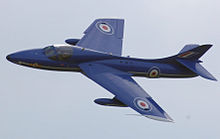Leading-edge extension

A leading-edge extension (LEX) is a small extension to an aircraft wing surface, forward of the leading edge. The primary reason for adding an extension is to improve the airflow at high angles of attack and low airspeeds, to improve handling and delay the stall. A dog tooth can also improve airflow and reduce drag at higher speeds.
Leading-edge slat
A
Dogtooth extension

A dogtooth is a small, sharp zig-zag break in the leading edge of a wing. It is usually used on a swept wing, to generate a
Many high-performance aircraft use the dogtooth design, which induces a vortex over the wing to control boundary layer spanwise extension, increasing lift and improving resistance to stall. Some of the best-known uses of the dogtooth are in the stabilizer of the
Leading-edge cuff
A leading edge cuff (or wing cuff) is a fixed aerodynamic device employed on fixed-wing aircraft to introduce a sharp discontinuity in the leading edge of the wing in the same way as a dogtooth. It also typically has a slightly drooped leading edge to improve low-speed characteristics.
Leading-edge root extension

A leading-edge root extension (LERX) is a small fillet, typically roughly triangular in shape, running forward from the leading edge of the wing root to a point along the fuselage. These are often called simply leading-edge extensions (LEX), although they are not the only kind. To avoid ambiguity, this article uses the term LERX.
On a modern
LERX were first used on the
A long, narrow sideways extension to the fuselage, attached in this position, is an example of a
Leading-edge vortex controller
Leading-edge vortex controller (LEVCON) systems are a continuation of leading-edge root extension (LERX) technology, but with actuation that allows the leading edge vortices to be modified without adjusting the aircraft's attitude.[4] Otherwise they operate on the same principles as the LERX system to create lift augmenting leading edge vortices during high angle of attack flight.
This system has been incorporated in the Russian Sukhoi Su-57 and Indian HAL LCA Navy.[5]
The LEVCONs actuation ability also improves its performance over the LERX system in other areas. When combined with the
See also
- Index of aviation articles
- Canard (aeronautics)
- Strake (aviation)
- Vortex generator
References
- ^ Effects of Wing-Leading-Edge Modifications on a Full-Scale, Low-Wing General Aviation Airplane, Nasa TP 2011
- ^ A Two-seat Gnat Development for the R.A.F. Flight 1959
- ^ Green, W. and Swanborough, G.; The complete book of fighters, Salamander, 1994
- ^ Lee, Gwo-Bin. "Leading-edge Vortices Control on a Delta Wing by Micromachined Sensors and Actuators" (PDF). American Institute of Aeronautics and Astronautics. Retrieved 18 October 2018.
- ^ Sweetman, Bill. "Sukhoi T-50 Shows Flight-Control Innovations". Aviation Week. Aviation Week & Space Technology. Retrieved 18 October 2018.
